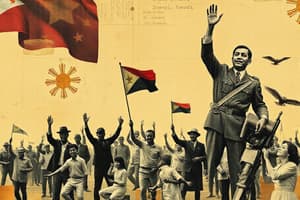Podcast
Questions and Answers
What was a key reason for the lack of pressure for invention and innovation among early Filipinos?
What was a key reason for the lack of pressure for invention and innovation among early Filipinos?
- Advanced technological advancements
- High population density
- Scarcity of natural resources
- Abundant natural resources and benign environment (correct)
What significant establishments were initiated during the Spanish regime in the Philippines?
What significant establishments were initiated during the Spanish regime in the Philippines?
- Military forts and trading posts
- Farms and fisheries
- Schools and hospitals (correct)
- Religious institutions and trade routes
What was one criticism of the anatomy course mentioned in the report?
What was one criticism of the anatomy course mentioned in the report?
- It was considered a 'farce'. (correct)
- It included too many participants.
- The facilities were too modern.
- Lectures were held too frequently.
Which of the following was a consequence of the opening of the Suez Canal in 1869?
Which of the following was a consequence of the opening of the Suez Canal in 1869?
How did the role of religious orders impact the development of science and technology in the Philippines?
How did the role of religious orders impact the development of science and technology in the Philippines?
Who among the following pursued studies in ophthalmology?
Who among the following pursued studies in ophthalmology?
Governor Francisco de Sande noted that Filipinos engaged in work primarily for which reason?
Governor Francisco de Sande noted that Filipinos engaged in work primarily for which reason?
What was a significant limitation of the educational facilities in the Philippines mentioned in the report?
What was a significant limitation of the educational facilities in the Philippines mentioned in the report?
What major change did the Spanish regime bring about in the education system in the Philippines?
What major change did the Spanish regime bring about in the education system in the Philippines?
What was one reason Filipinos migrated to Manila from their barangays?
What was one reason Filipinos migrated to Manila from their barangays?
What significant educational journey did many Filipino students undertake as a result of increased prosperity?
What significant educational journey did many Filipino students undertake as a result of increased prosperity?
What was the consequence of the absence of a written literary tradition among early Filipinos?
What was the consequence of the absence of a written literary tradition among early Filipinos?
What document is NOT mentioned as a source of understanding Filipino pre-colonial history?
What document is NOT mentioned as a source of understanding Filipino pre-colonial history?
Which group played a significant role in the establishment of the colonial educational system in the Philippines?
Which group played a significant role in the establishment of the colonial educational system in the Philippines?
What role did religious orders play in the education system of the Philippines during the colonial period?
What role did religious orders play in the education system of the Philippines during the colonial period?
Which statement is accurate regarding scientific advancements during the Spanish regime?
Which statement is accurate regarding scientific advancements during the Spanish regime?
What type of education was primarily provided during the Spanish regime at the primary level?
What type of education was primarily provided during the Spanish regime at the primary level?
Which aspect of medical education was introduced only after the American occupation?
Which aspect of medical education was introduced only after the American occupation?
In what year was the Ateneo de Manila established?
In what year was the Ateneo de Manila established?
Which graduate obtained a Ph.D. in pharmacy in Madrid?
Which graduate obtained a Ph.D. in pharmacy in Madrid?
What challenges did primary instruction face during the Spanish regime?
What challenges did primary instruction face during the Spanish regime?
Which religious order established schools in Manila to provide higher education?
Which religious order established schools in Manila to provide higher education?
What major factor contributed to the congestion of Manila?
What major factor contributed to the congestion of Manila?
Which subject was primarily taught in the early colonial education system due to the lack of resources?
Which subject was primarily taught in the early colonial education system due to the lack of resources?
What significant event occurred in Manila that impacted education and scientific activities?
What significant event occurred in Manila that impacted education and scientific activities?
Since independence in 1946, state support for education in the Philippines has remained primarily focused on which educational level?
Since independence in 1946, state support for education in the Philippines has remained primarily focused on which educational level?
What has contributed to the uneven standards among state universities and colleges in the Philippines?
What has contributed to the uneven standards among state universities and colleges in the Philippines?
Which university system is recognized as the most developed in terms of programs in the sciences and engineering?
Which university system is recognized as the most developed in terms of programs in the sciences and engineering?
What has been a key factor for the growth of state universities and colleges since 1946?
What has been a key factor for the growth of state universities and colleges since 1946?
What aspect of higher education in the Philippines has been a consistent challenge since independence?
What aspect of higher education in the Philippines has been a consistent challenge since independence?
What was a consequence of the Philippines' struggle for economic reconstruction post-independence?
What was a consequence of the Philippines' struggle for economic reconstruction post-independence?
What role did private colleges and universities play in the educational landscape of the Philippines post-independence?
What role did private colleges and universities play in the educational landscape of the Philippines post-independence?
What role did religious orders play in the technological innovation and scientific research during their missionary work?
What role did religious orders play in the technological innovation and scientific research during their missionary work?
What technology did the Spaniards introduce for urban development?
What technology did the Spaniards introduce for urban development?
What was a significant critique mentioned in the memorial sent to the Madrid exposition in 1887?
What was a significant critique mentioned in the memorial sent to the Madrid exposition in 1887?
According to Apolinario Mabini, what was a limitation faced by Filipinos in government employment?
According to Apolinario Mabini, what was a limitation faced by Filipinos in government employment?
Why did the Spaniards have to import Chinese artisans and builders?
Why did the Spaniards have to import Chinese artisans and builders?
What does the term 'political disturbances' refer to in the memorial to the Madrid exposition?
What does the term 'political disturbances' refer to in the memorial to the Madrid exposition?
Which of the following best describes the employment situation for Filipinos in government roles according to Mabini?
Which of the following best describes the employment situation for Filipinos in government roles according to Mabini?
What educational institutions did the religious orders help establish?
What educational institutions did the religious orders help establish?
Flashcards are hidden until you start studying
Study Notes
Historical Context and Technological Influence
- Early European medieval conditions mirrored the situation in the Philippines during colonization.
- Religious orders played a crucial role in technological innovation and scientific advancement to support their missionary activities.
- They worked to establish essential services like colleges, hospitals, and orphanages throughout the archipelago.
Spanish Contributions to Infrastructure and Education
- Spaniards introduced advanced town planning and construction techniques using stone, brick, and tiles.
- Bishop Salazar exemplified the leadership role of religious figures in fostering development in Manila.
- Due to a shortage of skilled Filipinos, Chinese artisans were imported for construction and craftsmanship purposes.
Criticism and Challenges in Education
- The University of Santo Tomas expressed concerns about government policies leading to political unrest among unemployed professionals.
- Apolinario Mabini highlighted the prevalence of Spanish personnel in government positions, limiting Filipino employment in administration and military roles.
- Serious deficiencies in educational resources were noted, including outdated textbooks and inadequate dissection practices in medical training.
Emergence of the Propaganda Movement
- The opening of the Suez Canal in 1869 facilitated access to liberal ideas and scientific knowledge from the West.
- Increased commerce allowed Filipino students, including key figures like Jose Rizal and Antonio Luna, to pursue higher education in Europe.
- This group initiated the Propaganda Movement, which contributed to the Philippine revolution against Spanish rule.
Educational Structure Under Spanish Rule
- Religious orders dominated the educational landscape, establishing schools primarily focused on religious instruction.
- Primary education was mainly provided by missionaries, while higher education was centered in urban areas, notably Manila.
- Jesuit and other religious colleges were established across the Philippines, including the Colegio de San Ildefonso and Ateneo de Manila.
Post-Independence Educational Trends
- The focus on education and training for scientists, engineers, and medical professionals remained largely unchanged after independence in 1946.
- State support predominantly targeted elementary education, while private institutions served most collegiate students.
- The number of state universities increased, but their development often lacked a strategic plan, with political factors influencing establishment and staffing.
- The University of the Philippines System remains the leading institution for higher education in science and engineering.
Studying That Suits You
Use AI to generate personalized quizzes and flashcards to suit your learning preferences.




